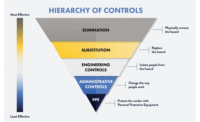Identifying hazards in the workplace, determining the degree of risk they represent, and taking appropriate action is a fundamental component of any safety management system. While simple to say, it can be more difficult in practice than we might expect.
Here are some areas we see especially challenging:
- Conditions are frequently changing and can introduce new hazards and/or can eliminate existing ones that were there prior to the condition change
- Risk tolerance can differ among individuals resulting in different assessments of the actions that should’ve been taken.
- Hazards that we’ve walked by countless times and nothing bad has happened, so we no longer see them.
In plain sight
We often experience this in real life, when an incident occurred and we heard someone say, “I’ve walked by that a thousand times and I just didn’t see it.” It wasn’t that we didn’t know that specific condition was a hazard to a safe working environment, we just didn’t see it. It was in plain sight, and we just didn’t see it. It could be a sharp edge, a spill on the floor, or even a moving piece of equipment. We just didn’t see until it was too late.
Improve your ability to see
There are three steps we can take to improve our ability to see what is in front of us and think more critically about it what it means and what we should do as a result.
- Slow down and take the time to properly assess our environment and the task that we are undertaking. Too often, we look but don’t take the time to really see because we feel the time pressure to get it done now. We look and immediately interpret that this time is like the last time and “fill in” what we think is there versus what might be different and harmful to our wellbeing.
- Establish a common language around risk tolerance so that everyone understands that no task is worth doing at the risk of injury. In order to “stop work” that is or becomes unable to be done without the risk of injury, we must be able to see the potential risk that is there. We must interpret what we see through having a disciplined way of seeing what is in front of us and processing it by thinking critically about the potential outcomes that can occur.
- Act based on what we see and what we have determined it means. This may mean applying a different approach to the task and a different level of safety controls, or stopping the work altogether until a safe plan of action can be determined. It does us no good to see it for what it is and then do nothing about it.
Enter Visual Literacy
This is where learning skills in Visual Literacy can alleviate these challenges. What do I see, what does it mean, and what do I do about it? Visual literacy is a form of critical thinking. By applying a proven and disciplined way of improving our ability to see what is in front of us, we have the potential to improve the decisions we make about how we do the work we do safely. Borrowing these lessons from art education, which teaches people how to interact with art, we can also apply these same principles in the workplace helping us all be safer as a result.
Tools to help identify hazards
One of the most fundamental ways employees can be engaged and participate in creating a safer working environment is by contributing to a rigorous hazard identification process. Even when we feel like we’ve identified all the hazards, the dynamic nature of most work environments continues to change – which can introduce new hazards or remove existing ones that could have been present only moments prior. And even if the environment is static, we can still miss hazards that over time have become normalized and are now part of the background.
So how do we deal with these constantly changing conditions? Both the ones that differ from the conditions anticipated by the job hazard analysis, or the ones that existed just moments before the pre-job brief was completed.
At COVE: Center of Visual Expertise, we believe that improving our ability to see by enhancing our Visual Literacy skills, we can respond more effectively to static or dynamic risks. We not only see in a more disciplined way, but by improving how we interpret the hazards before us we’re able to take meaningful actions.
We often emphasize that we need to slow down in order to really appreciate what we are examining. But slowing down without having the proper tools or insight on how to use them may not be effective. Visual Literacy provides concepts to help move from just looking to really seeing, and from jumping to a conclusion to confidently interpreting what we are seeing in a more systematic way. By training our employees to utilize these tools in their normal working environments, they become re-engaged –improving the impact their efforts can have on safety performance.
To download a free White Paper on “Seeing the Gaps in Your Safety Program, go to https://covectr.com/seeing-the-gaps-in-your-safety-program/.






